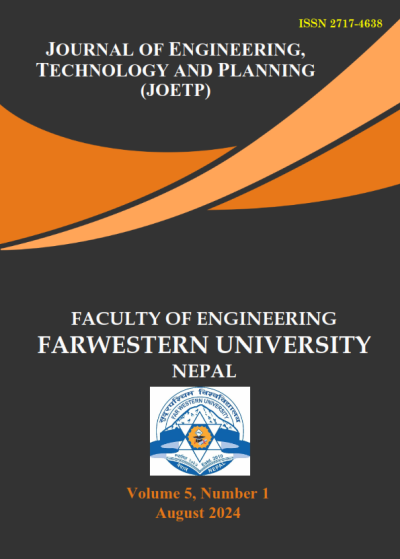Status of Construction Safety in Local Road Bridge Construction and its Consequences in Project Implementation: A Study in Gandaki Province, Nepal
DOI:
https://doi.org/10.3126/joetp.v5i1.69725Keywords:
Bridge construction, construction safety status, project implementation, ConsequencesAbstract
After federalization of Nepal, bridge construction in local roads by provincial levels is in increasing trend. Being highly technical and of risky nature, construction safety needs to be ensured in bridge construction. However, in countries like Nepal, safety issues are considered, with follow up measures, only after the accidents occur at construction sites. In this context, this study aims to assess the present status and consequences of construction safety in local roads bridge project implementation and explore some improvements measures. A quantitative descriptive design was adopted for the study and 30 completed bridge samples from Gandaki province were selected using convenience sampling. Data were collected using questionnaire survey with 56 participants directly related to bridge construction and policy implementation. This study revealed that most of the bridge construction sites have poor workplace safety and worker’s welfare, inadequate provision and use of PPE, lack of trainings and awareness to workers as well as the absence of safety plans and method statements. Similarly, provisions for unsafe supports, shoring, formworks, concreting, and demolition were not noticed. While the absence of safety supervisor, job safety analysis, recording and reporting accident and diseases was observed, abundant cases were found where less importance was given to construction safety and use of PPE undermining the engineering and administrative hazard control methods in road bridge construction. Slip/trip/low falls, hand/leg/head injury, falling from height, eye problem, injury during erections, vehicle and electric current, cost and time overrun, substandard quality, reduced workers’ productivity, increased workers turnover, low construction safety reputation of contractor, loss/damage of land, irrigation canal, drinking water scheme, dust/noise have been found as consequences of poor safety practices. This clearly indicates that present bridge construction safety practices are inadequate and need substantial improvements for better project implementation. The major areas of improvements include safety as first priority, willingness, awareness and commitment of management, contractor and worker, selection of competent workers, formulation of specific safety rules, regulations, codes and their strict enforcement, good communication, safety training and inspection, motivation, adequate budget provision in contract for safety, provision of PPE, feeling safety as self-responsibility and use of technologies as well.
Downloads
Downloads
Published
How to Cite
Issue
Section
License
Copyright © Faculty of Engineering, Far Western University

